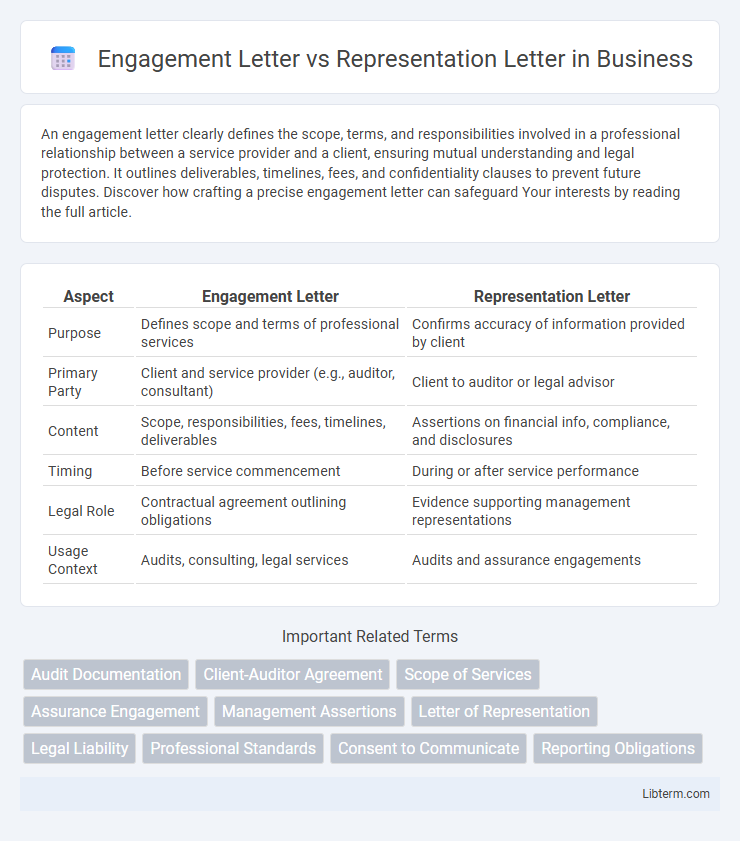An engagement letter clearly defines the scope, terms, and responsibilities involved in a professional relationship between a service provider and a client, ensuring mutual understanding and legal protection. It outlines deliverables, timelines, fees, and confidentiality clauses to prevent future disputes. Discover how crafting a precise engagement letter can safeguard Your interests by reading the full article.
Table of Comparison
| Aspect | Engagement Letter | Representation Letter |
|---|---|---|
| Purpose | Defines scope and terms of professional services | Confirms accuracy of information provided by client |
| Primary Party | Client and service provider (e.g., auditor, consultant) | Client to auditor or legal advisor |
| Content | Scope, responsibilities, fees, timelines, deliverables | Assertions on financial info, compliance, and disclosures |
| Timing | Before service commencement | During or after service performance |
| Legal Role | Contractual agreement outlining obligations | Evidence supporting management representations |
| Usage Context | Audits, consulting, legal services | Audits and assurance engagements |
Introduction to Engagement Letters and Representation Letters
Engagement letters define the scope, terms, and objectives of professional services agreed upon between clients and service providers, ensuring clarity and mutual understanding before work commences. Representation letters are written assertions provided by management to auditors, confirming the accuracy and completeness of information shared during an audit. Both letters are essential in formalizing professional relationships and safeguarding responsibilities in auditing and consulting processes.
Definition of Engagement Letter
An engagement letter is a formal written agreement outlining the scope, objectives, responsibilities, and terms between a professional service provider, such as an auditor or consultant, and a client. It serves to clarify the nature of the services to be performed, establish expectations, and protect both parties by detailing deadlines, deliverables, fees, and confidentiality clauses. This document ensures a clear mutual understanding before work commences, distinguishing it from a representation letter, which is typically a statement provided by the client to confirm the accuracy and completeness of information during or after the engagement.
Definition of Representation Letter
A Representation Letter is a formal document provided by a client to an auditor or legal professional, confirming the accuracy and completeness of information related to a specific engagement. It serves as a written assurance that facts and statements presented during the audit or legal review are truthful and reliable. Unlike an Engagement Letter, which outlines the scope and terms of the professional relationship, the Representation Letter specifically verifies the client's assertions and supports the professional's conclusions.
Key Differences Between Engagement and Representation Letters
Engagement letters outline the scope, objectives, and terms of professional services agreed upon between a client and a service provider, specifying responsibilities and timelines. Representation letters, typically prepared by management and addressed to auditors, confirm the accuracy and completeness of information provided during an audit or review. The key differences include the engagement letter's role in establishing the contractual agreement for services, while the representation letter serves as a formal assertion verifying management's representations and disclosures.
Purpose of an Engagement Letter
An engagement letter serves as a formal agreement that outlines the scope, objectives, and responsibilities between a service provider, such as an auditor or consultant, and the client, ensuring clarity and mutual understanding before the commencement of work. It defines the specific services to be performed, timelines, deliverables, fees, and limitations of liability, establishing a contractual foundation to prevent misunderstandings and legal disputes. Unlike a representation letter, which is typically issued at the conclusion of an audit to confirm information provided, the engagement letter initiates the professional relationship by setting clear expectations and boundaries.
Purpose of a Representation Letter
A representation letter serves as written confirmation from management to auditors, providing assurances about the accuracy and completeness of financial statements during an audit. This letter helps auditors obtain sufficient appropriate evidence by verifying that all relevant information and disclosures have been made. Engagement letters, in contrast, outline the scope, objectives, and responsibilities of both parties before the audit begins.
Legal Significance and Binding Nature
An Engagement Letter outlines the scope, terms, and conditions of services between a client and a professional, establishing a contractual agreement with clear responsibilities and expectations but typically does not serve as evidence in court. A Representation Letter is a formal document provided by a client to a professional, such as an auditor or lawyer, affirming the accuracy and completeness of information, carrying legal significance as it can be used as evidence and may create liability if false. The binding nature of an Engagement Letter lies in contract law, while a Representation Letter holds legal weight by confirming assertions made, potentially impacting legal and financial accountability.
Common Contents of Engagement Letters
Engagement letters typically outline the scope of work, responsibilities of both parties, fees, and timelines to establish clear expectations in professional services. Common contents include the nature and objectives of the engagement, confidentiality clauses, limitations of liability, and procedures for termination or amendments. Unlike representation letters that confirm facts or assertions at the conclusion of work, engagement letters serve as the foundational agreement prior to service delivery.
Common Contents of Representation Letters
Representation letters commonly include management's assertions about financial statements accuracy, disclosure of all relevant information, compliance with laws and regulations, and confirmation of ownership of assets and liabilities. These letters provide auditors with written evidence supporting management's responsibility for the preparation of financial statements and enhance audit quality. Engagement letters, by contrast, outline the scope, objectives, and responsibilities of both parties but do not typically contain detailed financial assertions found in representation letters.
Choosing the Right Letter: Best Practices for Professionals
Choosing the right letter is crucial for maintaining clarity and legal protection in professional relationships. Engagement letters clearly define the scope, deliverables, responsibilities, and fees between a service provider and client, ensuring mutual understanding before work begins. Representation letters, commonly used in auditing and legal settings, confirm facts and assertions from the client to the professional, supporting the accuracy and reliability of the reported information.
Engagement Letter Infographic

 libterm.com
libterm.com